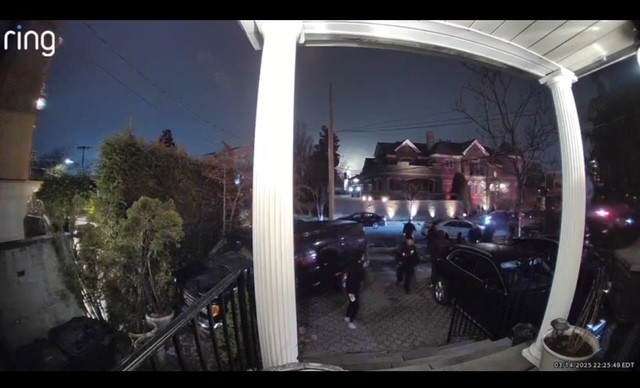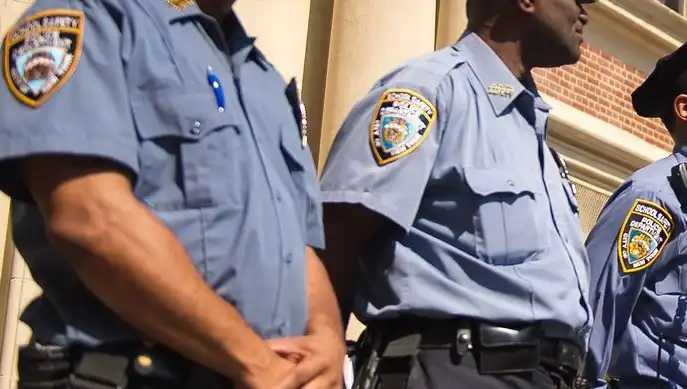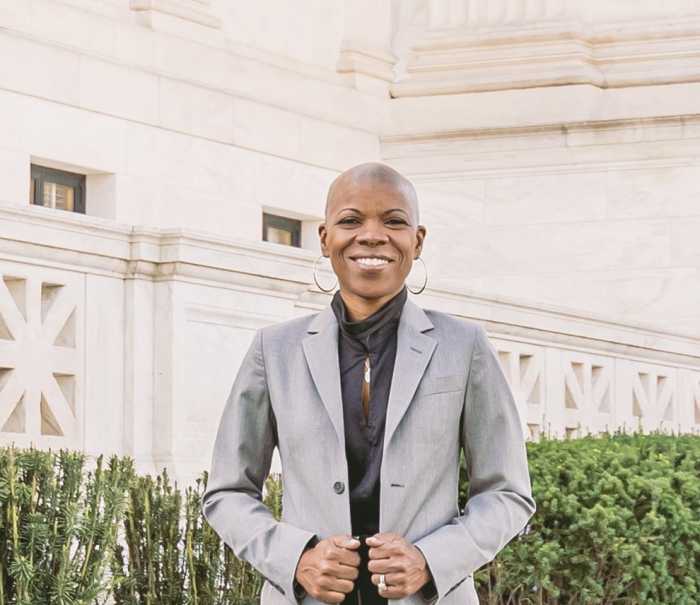Ridgewood School Blasts DOE Proposal
Frustrated parents, teachers and students voiced their outrage over the Department of Education’s (DOE) controversial “turnaround” plan for Grover Cleveland High School during the Citizens for a Better Ridgewood meeting on Monday night, Mar. 26, at St. Aloysius Church.

Elaine Gorman of the DOE got an earful of complaints from attendees about the proposal, which will result in the closure of Grover Cleveland in June, the opening of a brand new high school on its campus in September and the potential replacement of at least 50 percent of the current faculty.
Members of the Grover Cleveland school community also spoke out about the state of the high school, in- cluding statistical, educational and social improvements. Many in attendance claimed that the “turnaround” proposal by the DOE would only serve to interrupt and erode the progress made by those involved in the education of its students.
Monday’s session, moderated by CBR Vice President Michael Hetzer, was a preview of the DOE’s official public hearing on the proposal, which is scheduled to take place this Mon- day night, Apr. 2, at 6 p.m. in the Grover Cleveland High School auditorium. Gorman noted that the comments received at the session would be used by the Panel for Educational Policy (PEP) to determine its final decision on the “turnaround” plan at their Apr. 25 meeting in Brooklyn.

Understanding the turnaround
At the start of the meeting, Gorman explained the turnaround plan slated to be enacted at Grover Cleveland and seven other high schools across Queens.
Each of the eight schools were previously identified by the state Department of Education as being “persistently lowest achieving”; Gorman explained that the designation recognizes that every school had a fouryear graduation rate below 60 percent over three consecutive years.
“That does not mean the school is not doing a good job,” the DOE official caution. “They’re just not able to graduate enough students.”
After being designated as a “persistently lowest achieving” school last year, Gorman stated, the DOE chose to enact at Grover Cleveland one of four education models under the federal No Child Left Behind Act, enabling the institution to receive funding for support services. Grover Cleveland was designated as a “restart” school, meaning that the institution would be paired with an educational support organization to receive programs to enhance student education and professional development.
But Grover Cleveland and other high schools across the city under this model lost their funding on New Year’s Day 2012 after the city DOE and the United Federation of Teachers (UFT) failed to agree upon a teacher evaluation program. Gorman said that, under federal law, such an initiative had to be enacted in order for the city DOE to receive $58 million in federal grants.
“We cannot go forward with these schools” without that funding, she told residents. “It’s just not allowable.”
The DOE decided to adopt the “turnaround” model at Grover Cleveland and other New York City high schools, Gorman claimed, to regain federal funding and also “to continue” and enhance “the good work started” at each institution.
Under the plan, Grover Cleveland High School would be closed at the conclusion of the current school year in June. Over the summer, a new school-complete with a new name and public school number-would be established on the Grover Cleveland campus and opened in September.
All incoming sophomores, juniors and seniors at Grover Cleveland will be guaranteed a seat at the new school, while new freshmen will be admitted through the standard citywide high school admission process.
While the current principal, Denise Vittor, will serve in the same position at the new school, all current teachers and staff will be required to reapply for their positions, Gorman stated. She claimed that under the current collective bargaining agreement, “at least 50 percent” of the current faculty will be retained.
“We will look to put the best teachers in the classrooms with the students of the school,” she added. “The new school will build on the strongest elements of the older school.”
In recent visits to Grover Cleveland, Gorman stated that she found “a lot of good things” such as increased technological education which will be expanded and enhanced in the new school if the turnaround plan is adopted. The plans also call for an expansion of literacy goals “to meet the needs of English language learners and students with disabilities” and a focus on social responsibility and “college readiness.”
‘Disgusted with’ the DOE
Lydia Martinez, the treasurer of Grover Cleveland’s parent-teacher association, stated that she was upset by the turnaround plan, charging that the DOE had not given the school and its new principal much of a chance to make improvements.
“The [former] principal had to make drastic changes because the budget was cut” last year, Martinez said, going on to note that the principal was forced to resign after becoming sickened by the stress.
“I’m so disgusted with the DOE,” added Martinez, a mother of two Grover Cleveland students. “We got a new principal, and she’s not going to be given a chance to continue the work under the restart model. It’s unfair to everyone in the whole school community. It’s unfair to all of us.”
Gorman publicly apologized for the “uncomfortable and disruptive” feeling expressed by many within the Grover Cleveland community. However, she noted that Vittor will be allowed to continue and expand her work under the turnaround model.
“For whatever reason, we are where we are, and we can’t go forward with the restart,” she said.
Among the several students who spoke out about the positives of the school was Max Pena, who said that the teachers have helped him take him on “a better path.” In particular, he blasted the proposed elimination of the school’s name.
“If you took the New York Yankees and put a different name on them, then they wouldn’t be the Yankees,” he said. “It would be just another baseball team.”
Teachers losing confidence
Russell Nitchman, a science teacher at the high school, added that the turnaround plan has lowered “the morale of the school.” Though “we have a lot of wonderful teachers at Grover Cleveland,” he noted, many are beginning to question if their efforts are worth anything since many of them will not be returning next year.
“We’ve made improvements and are working our butts off, and yet you want to disrupt that,” Nitchman told Gorman. “No one wants it.”
“I’m trying to convince teachers within my academy to put their heart and soul and do the right thing for the kids,” added Brian Campbell, coordinator of one of Grover Cleveland’s academy programs. “How could I convince those people that they’re going to be there to see the fruits of their labor?”
“This model is going to wind up disrupting all of the progress we’ve made,” said Assistant Principal Gregory Ambrosini. “Ninety-nine percent of this staff is hard-working and dedicated.”
Krystyna Levy, an ESL teacher at Grover Cleveland, added that the state Education Department failed to take into account that many Grover Cleveland students are English language learners, many of whom graduate require many years in order to gain the proficiency in English needed to pass state exams.
“If we are not graduating them fast enough, what is the solution?” Levy asked. “If we have the same population, how ist hat going to change? If they replace me, are [the ESL students] going to be better? I don’t believe that.”
Noting that up to 70 percent of Grover Cleveland’s population is made up of current or former ESL students, guidance counselor Iris Rosario stated that “whether it takes them four, five, six or seven years” to graduate, “they’re still accomplishing it.”
“My students have been here only a few years … and they’re reading ‘Fahrenheit 451,'” added ESL master teacher Maria Rozos, referring to the Ray Bradbury novel. “These are second language learners, some of whom are illiterate in their own language.” She noted that the teachers “work tirelessly” with ESL students and offer tutoring during after-school hours and on Saturdays to the pupils and, in some cases, their parents.
A costly ‘temper tantrum’
Despite Gorman’s statements that the failure of a deal on a teacher evaluation system cost public high schools millions in funding, Dermot Smyth of the UFT argued that money or the quality of education had little do with the decision to implement the turnaround plan at Grover Cleveland and other high schools.
“This has nothing to do with bad teachers. It has everything to do with a mayor having a temper tantrum” and refusing to negotiate in good faith with the UFT, Smyth claimed. He charged that the UFT tried to keep negotiations over the teacher evaluation plan going right up to the deadline, but the DOE-purportedly under the mayor’s direction-decided instead to pull out of talks.
The end result of the turnaround plan, he stated, is that the DOE will be spending millions of dollars to hire new teachers at each school, but will continue to keep current teachers employed elsewhere.
“We are welcome to bringing in new staff, but this is not the way to do it,” he added. “That money should be going to the children. Instead, it’s going to be used to hire new staff.”
James Vasquez, the UFT representative at Grover Cleveland, further contended that the mayor has stated he would support the turnaround proposals even if a teacher evaluation deal is reached between the DOE and the teachers’ union.
“It’s not even about the money anymore,” he said. “The mayor absolutely has a choice,” adding that there’s nothing preventing the city from reapplying for federal funds for the restart model.
‘Give her a chance’
Joann Berger, president of the District 24 PTA Presidents Council, stated that the organization would pass a resolution condemning the DOE’s plan for Grover Cleveland and urging them to continue to let Vittor and the current faculty operate under the restart model. She pointed out that Vittor helped improve the quality of education at Queens Vocational High School, which was recently removed from the “persistently lowest achieving” list recently.
“She has a track record,” Berger said. “Let’s give her a chance to do it” at Grover Cleveland.
Echoing those sentiments was CBR President Ann Maggio, who stated that Vittor “is trying her best to put Cleveland where it was,” adding that “it used to be the star of Ridgewood, and we want Cleveland back in that realm.”
‘It’s already in the bag’
The importance of the Apr. 2 public hearing with regard to the high school’s future was called into question by Patricia Grayson, chair of Community Board 5’s Education Committee. She noted that Gorman’s explanation of the turnaround model sounded as if the DOE had already made up its mind.
“Why are you having hearings?” she asked Gorman. “It’s already in the bag. … Why are you having a hearing if you’re not going to listen?”
Berger added that “with all due respect, the PEP doesn’t listen” to public comments, pointing out that the majority of the panel is comprised of appointees of Mayor Bloomberg.
Gorman stressed that “the purpose of the hearing is to put your voice on the record,” adding that there have been instances in which a strong public outcry expressed at a public hearing led PEP and the DOE to make changes to their plans.
Dmytro Fedkowskyj, a PEP member appointed by Queens Borough President Helen Marshall, added that he has drafted a resolution calling for the panel to reject the turnaround model at Grover Cleveland and other high schools across the city.
“The problem is bigger than this proposal or that policy,” he argued. “That problem hasn’t been addressed.
Prior to this Monday’s public hearing, residents can submit written or oral comments on the Grover Cleveland plan to Gorman and the DOE by e-mail to D24proposals@schools.nyc. gov or by calling 1-212-374-7621.
The next meeting of the Citizens for a Better Ridgewood is scheduled to take place on Monday night, Apr. 30, at 7:30 p.m. in the lower level of St. Aloysius Church, located at 382 Onderdonk Ave.





































